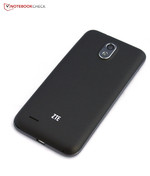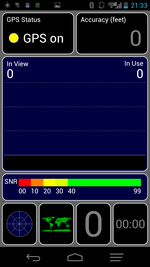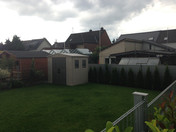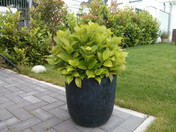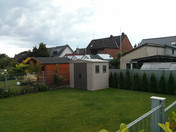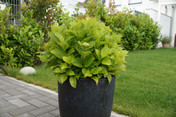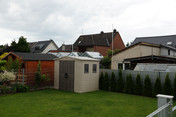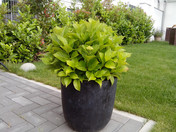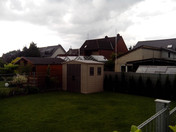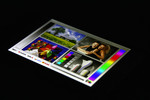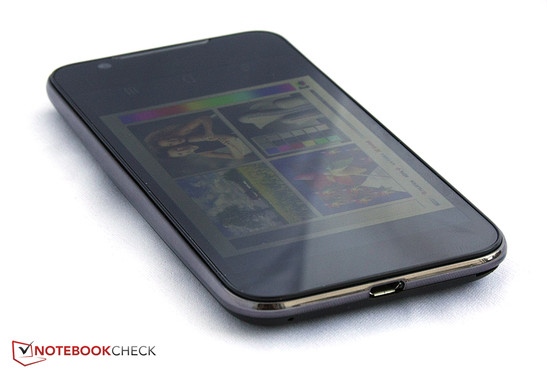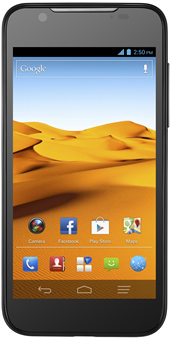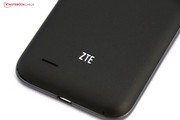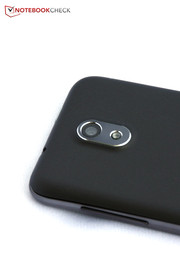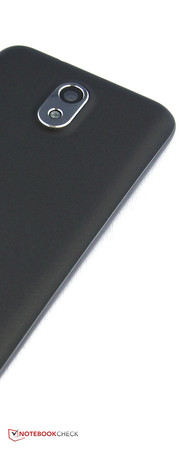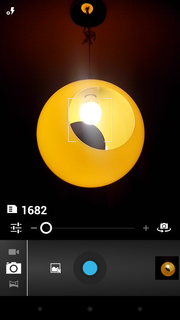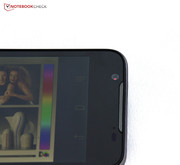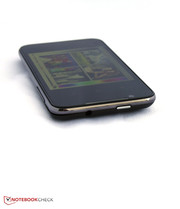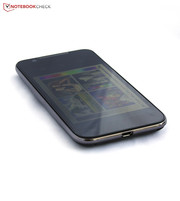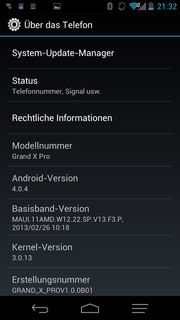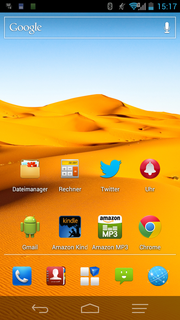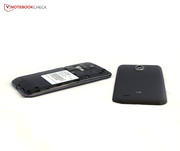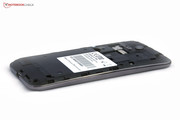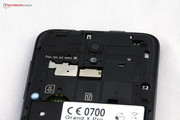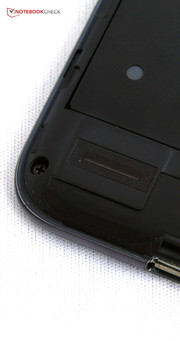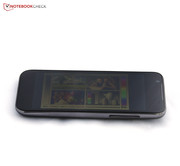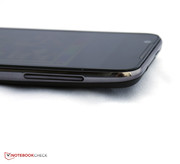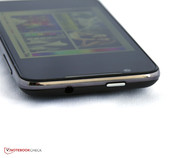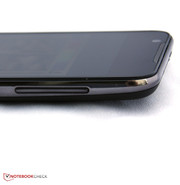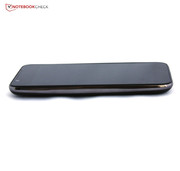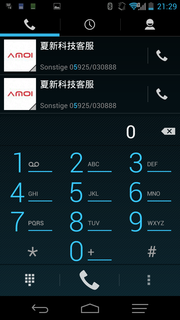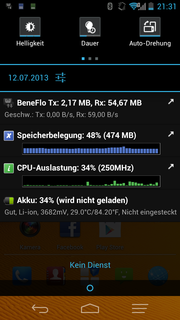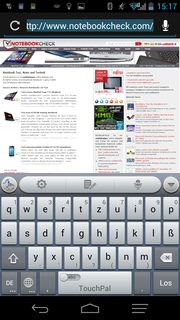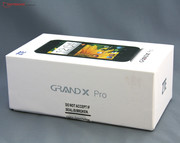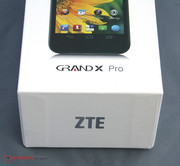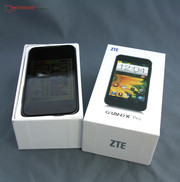Review ZTE Grand X Pro Smartphone

For the original German review, see here.
We reviewed ZTE's Grand X IN a few months ago. Although it only had a few striking features, the smartphone with Intel's Atom processor convinced us. Now ZTE's Grand X Pro is in our test lab. This time it features an SoC from MediaTek, a somewhat larger, 4.5-inch screen, a higher screen resolution and 4 GB of storage. Compared with the Grand X IN, improvements have been made but its price is virtually unchanged. The phone is available for a recommended price of 269 Euros (~$354).
Dozens of manufacturers, ranging from brand names up to Far Eastern budget manufacturers, have meanwhile found their way in the affordable mid-range category. Consequently there are many devices that can be compared with ZTE's Grand X Pro, e.g. Acer's Liquid E1 Duo, Yarvik's Ingenia X1, Alcatel's One Touch Ultra 997D, Amoi's N821, LG's Optimus L7 II, Sony's Xperia L or Nokia's Lumia 620 that features Windows Phone 8 operating system. The to-date unbeaten price-performance winner Google Nexus 4 is also available for 100 Euros (~$131) more.
Case
ZTE's Grand X Pro comes in a high-quality looking casing devoid of thrills. Its back is dark-gray plastic, the front features a black display frame and a chrome-colored bezel is between that on the sides. Like Samsung's cellphones, the back can be removed and is quite slip-proof. Its only keys are a standby button on the top and a volume rocker on the right. The manufacturer even omits the usual physical buttons below the screen. They have simply been moved to the screen, which naturally lessens the surface area for other contents.
The build is decent in so far as the gaps between the single materials are flush and no palpable edges are noticed. The stability is also basically acceptable but the smartphone can be twisted which causes light waves in the liquid crystals on the screen. These waves also become visible when light pressure is applied to the screen. This effect does not occur in other smartphones even when higher pressure is applied. The touchscreen should thus be handled with care.
Connectivity
The micro-USB port on the bottom and the 3.5 mm audio jack on the top are positioned like on most other smartphones. Besides that, the device only brings along a SIM card slot and micro SD card reader located underneath the back cover.
Software
Google's popular Android operating system is installed. However, it is a somewhat outdated edition. Android 4.0 Ice Cream Sandwich is the third last version of the operating system. Whether an update will be available is not yet known even upon inquiring.
ZTE basically has not modified the operating system. However, some smaller apps have been extended. For example, "Mi-EasyAccess" opens a circle that displays the most frequently used apps and the user is directly led to the intended app. However, there is a problem when it is the start screen because it cannot be linked. It is only possible to remedy this by enabling the PIN code in the security settings or using another option to unlock the phone.
Otherwise, the user will find many small extras like a free messenger, which friends of course must also have for it to work. Besides that, there is an office suite and software that makes friends' Facebook pictures into a slideshow which opens when they call. Overall, ZTE includes a quite extensive software bundle.
Communication & GPS
Support for various frequencies and fast Wi-Fi are a must in a modern smartphone. ZTE's Grand X Pro features GSM tri-band and UMTS dual-band as well as HSPA support. Even Bluetooth 4.0 is on board. The Wi-Fi module supports wireless networks that comply with 802.11 b/g/n standards.
However, the Wi-Fi module does not have a far range. Sometimes only three out of four signal bars were displayed even in the router's direct vicinity. A distance of ten meters and two walls between the router and phone reduced this to only two bars, so half the strength. This also affected internet speed. Websites loaded much slower. Another two meters and an additional wall between the phone and the router decreased the signal strength to only one bar.
We could not coax the installed GPS module to set up a satellite connection in our test. A signal was not found even on a clear day in an open field.
Telephony & Speech Quality
Google's default telephone app version is used. ZTE did not modify anything here and the app can be intuitively used as usual. The speech quality is satisfactory when a mini-SIM card is inserted and a call is started. Both the called person and the person calling were understood well. However, the sound from the smartphone was a bit muffled. The speaker is a bit too weak to hear the called party clearly in loud situations when the hands-free mode is enabled.
Cameras & Multimedia
An 8 megapixel camera is installed on the back, which corresponds to 3264x2448 pixels. The front-facing camera is only suitable for video calls due to a resolution of 640x480. ZTE has left the camera app untouched and the panorama function and video recordings are available. The camera's still pictures are quite good and high in detail. Color noise remains within limits even in difficult, so comparatively dark situations. The Grand X Pro can compete with the cameras in high-end smartphones. In particular, the crisp colors and good display of details were noticed favorably. Nevertheless, the camera cannot hold a candle to the luminosity and level of detail of a reflex camera.
Videos are however only recorded in 640x480 pixels. The picture quality features much lower details and more noise. Sound recordings also overdrive quickly. Our phone did not have any problems with playing videos. Even Full HD videos were rendered smoothly on ZTE's Grand X Pro. However, we found it annoying that the controls were recurrently faded in and out of the picture in full-screen mode since there are no dedicated touch-buttons below the screen, which makes playback without controls impossible.
Accessories
The usual accessories for a mid-range smartphone are included: A charger alongside a separate USB cord and a headset. ZTE does not yet have its own online shop in some countries and no device-specific accessories are found on ZTE's international websites.
Warranty
The included warranty period is a pleasing 24 months. A repair order can be placed via a specified online platform or hotline. A few questions are asked beforehand in order to exclude any defects that the customer can repair on their own.
Input Devices & Controls
The virtual keyboard is not Google's default model but a version dubbed "TouchPal". Although the keys are slightly smaller, it enables quick access to alternative input methods. For example, speech input or "Curve" where the user strokes over the keyboard instead of tapping.
It is also possible for the user to access many special keys for internet applications or a function that facilitates highlighting texts. It is generally a comprehensive keyboard app. However, users who want large letter keys should look for an alternative. The touchscreen works reliably and even using the screen's edge is a pleasant matter.
Display
ZTE's Grand X Pro has a lead on all its contenders with a resolution of 1280x720 pixels. All devices used for comparison feature a lower resolution. However, the brightness of our review sample is category average. Devices like Sony's Xperia L or Nokia's Lumia 620 manage a much better rate. Our review sample's illumination of 86% is also rather moderate.
| |||||||||||||||||||||||||
Brightness Distribution: 86 %
Center on Battery: 363 cd/m²
Contrast: 741:1 (Black: 0.49 cd/m²)
ΔE Color 8.8 | 0.5-29.43 Ø5
ΔE Greyscale 10.6 | 0.57-98 Ø5.3
Gamma: 2.17
The contrast of 741:1 is at the lower end of the comparison field and the black value of 0.49 cd/m² is middling. Black areas look like black subjectively and the colors are quite brilliant.
We also examined the screen's reproduction using the colorimeter and CalMAN software. Here we noticed that many hues deviate extremely from the ideal value of the reference color space. Light blue, orange, purple, light brown and particularly white were over a DeltaE rate of 10.
It is similar in the grayscale. Especially light colors deviate extremely. The deviation decreases towards black. The saturation shows that the blue part is very low while green is overemphasized in the color mixing. This, for example, causes skin tones to look rather unnatural because they lack green.
It was noticed in the excellent TFT screen of HTC's One that TFT technology has advanced greatly in the past years. ZTE's Grand X Pro also features such a TFT screen and thus offers an equally good viewing angle stability as IPS or AMOLED screens. Pictures can be viewed from very acute angles without losing contrast.
Performance
MediaTek's MT6577 is a popular SoC and is installed in four devices besides ZTE's Grand X Pro in our comparison field. The serial number of the SoC in our device features a "T" which indicates a slightly higher processor clock rate of 1.2 GHz (MediaTek M6577: 1 GHz). The PowerVR SGX531 graphics unit is the same. Apart from that, the system has 1 GB of RAM and 4 GB of storage available.
The processor's increased rates only have small advantages at first. Our review sample is generally on a par with the compared devices in the benchmarks that test the entire system. However, the processor-only test Linpack recorded a 10% advantage particularly in the multi-core scenario compared with devices that feature MediaTek's M6577 SoC (Amoi N821, Acer Liquid E1 Duo).
| Geekbench 2 - 32 Bit - Total Score (sort by value) | |
| ZTE Grand X Pro | |
| Amoi N821 | |
| Alcatel OneTouch Ultra 997D | |
| LG P710 Optimus L7 II | |
| Sony Xperia L | |
| Google Nexus 4 | |
| Acer Liquid E1 Duo | |
| Yarvik Ingenia X1 | |
| AnTuTu v3 - Total Score (sort by value) | |
| ZTE Grand X Pro | |
| Amoi N821 | |
| Alcatel OneTouch Ultra 997D | |
| LG P710 Optimus L7 II | |
| Sony Xperia L | |
| Google Nexus 4 | |
| Acer Liquid E1 Duo | |
| Yarvik Ingenia X1 | |
| Quadrant Standard Edition 2.0 - --- (sort by value) | |
| ZTE Grand X Pro | |
| Amoi N821 | |
| Sony Xperia L | |
| Google Nexus 4 | |
| Acer Liquid E1 Duo | |
| Linpack Android / IOS | |
| Single Thread (sort by value) | |
| ZTE Grand X Pro | |
| Amoi N821 | |
| LG P710 Optimus L7 II | |
| Sony Xperia L | |
| Google Nexus 4 | |
| Acer Liquid E1 Duo | |
| Multi Thread (sort by value) | |
| ZTE Grand X Pro | |
| Amoi N821 | |
| LG P710 Optimus L7 II | |
| Sony Xperia L | |
| Google Nexus 4 | |
| Acer Liquid E1 Duo | |
| PassMark PerformanceTest Mobile V1 - System (sort by value) | |
| ZTE Grand X Pro | |
| Sony Xperia L | |
| Google Nexus 4 | |
| Acer Liquid E1 Duo | |
In the review of Acer's Liquid E1 Duo we observed that the graphics card does not work well with 3DMark. Basemark X also aborted every run on ZTE's Grand X Pro.
It quickly becomes obvious in the other synthetic benchmarks that Sony's Xperia L and Google's Nexus 4 are clearly superior in terms of 3D power. The other compared devices that actually feature the same graphics unit as ZTE's Grand X Pro have an average lead of 20% on our review sample.
| AnTuTu 3DRating | |
| --- (sort by value) | |
| ZTE Grand X Pro | |
| LG P710 Optimus L7 II | |
| Sony Xperia L | |
| Google Nexus 4 | |
| Acer Liquid E1 Duo | |
| Yarvik Ingenia X1 | |
| 1024x2048 Off-screen (sort by value) | |
| ZTE Grand X Pro | |
| LG P710 Optimus L7 II | |
| Sony Xperia L | |
| Google Nexus 4 | |
| Acer Liquid E1 Duo | |
| Yarvik Ingenia X1 | |
| GFXBench (DX / GLBenchmark) 2.7 | |
| 1920x1080 T-Rex Offscreen (sort by value) | |
| ZTE Grand X Pro | |
| LG P710 Optimus L7 II | |
| Sony Xperia L | |
| Google Nexus 4 | |
| T-Rex Onscreen (sort by value) | |
| ZTE Grand X Pro | |
| LG P710 Optimus L7 II | |
| Sony Xperia L | |
| Google Nexus 4 | |
| Epic Citadel | |
| High Quality (sort by value) | |
| ZTE Grand X Pro | |
| LG P710 Optimus L7 II | |
| Sony Xperia L | |
| Google Nexus 4 | |
| Acer Liquid E1 Duo | |
| High Performance (sort by value) | |
| ZTE Grand X Pro | |
| Alcatel OneTouch Ultra 997D | |
| LG P710 Optimus L7 II | |
| Sony Xperia L | |
| Google Nexus 4 | |
| Acer Liquid E1 Duo | |
| Acer Liquid E1 Duo | |
| Yarvik Ingenia X1 | |
| GLBenchmark 2.5 - Egypt HD Fixed Time (sort by value) | |
| ZTE Grand X Pro | |
| LG P710 Optimus L7 II | |
| Google Nexus 4 | |
| Yarvik Ingenia X1 | |
| NenaMark2 - --- (sort by value) | |
| ZTE Grand X Pro | |
| Amoi N821 | |
| Alcatel OneTouch Ultra 997D | |
| LG P710 Optimus L7 II | |
| Sony Xperia L | |
| Google Nexus 4 | |
| Acer Liquid E1 Duo | |
| Yarvik Ingenia X1 | |
Our review sample also frequently lagged behind the actually marginally weaker comparison devices with MediaTek's MT 6577 in the other browser benchmarks. This was noticed in the slightly longer time needed for opening pages. Browsing did not seem as smooth as on some other devices. The Wi-Fi module's weak reception performance (see above) also contributes to this mediocre impression.
| Peacekeeper - --- (sort by value) | |
| ZTE Grand X Pro | |
| Amoi N821 | |
| Alcatel OneTouch Ultra 997D | |
| LG P710 Optimus L7 II | |
| Sony Xperia L | |
| Nokia Lumia 620 | |
| Google Nexus 4 | |
| Acer Liquid E1 Duo | |
| Google V8 Ver. 7 - Google V8 Ver. 7 Score (sort by value) | |
| ZTE Grand X Pro | |
| Amoi N821 | |
| Alcatel OneTouch Ultra 997D | |
| LG P710 Optimus L7 II | |
| Sony Xperia L | |
| Nokia Lumia 620 | |
| Google Nexus 4 | |
| Acer Liquid E1 Duo | |
| Acer Liquid E1 Duo | |
| Acer Liquid E1 Duo | |
| Yarvik Ingenia X1 | |
| Octane V1 - Total Score (sort by value) | |
| ZTE Grand X Pro | |
| LG P710 Optimus L7 II | |
| Sony Xperia L | |
| Google Nexus 4 | |
| Acer Liquid E1 Duo | |
| Vellamo Mobile Benchmark 2.0 | |
| Metal (sort by value) | |
| ZTE Grand X Pro | |
| Amoi N821 | |
| Alcatel OneTouch Ultra 997D | |
| LG P710 Optimus L7 II | |
| Sony Xperia L | |
| Google Nexus 4 | |
| Acer Liquid E1 Duo | |
| Yarvik Ingenia X1 | |
| HTML5 (sort by value) | |
| ZTE Grand X Pro | |
| Amoi N821 | |
| Alcatel OneTouch Ultra 997D | |
| LG P710 Optimus L7 II | |
| Sony Xperia L | |
| Google Nexus 4 | |
| Acer Liquid E1 Duo | |
| Yarvik Ingenia X1 | |
The storage device access time is average. For example, while the Amoi N821 reads data much slower, the Yarvik Ingenia X1 has the clear lead. Even the Xperia L is often defeated in this exercise.
| AndroBench 3-5 | |
| Sequential Read 256KB (sort by value) | |
| ZTE Grand X Pro | |
| Amoi N821 | |
| Alcatel OneTouch Ultra 997D | |
| LG P710 Optimus L7 II | |
| Sony Xperia L | |
| Google Nexus 4 | |
| Acer Liquid E1 Duo | |
| Yarvik Ingenia X1 | |
| Sequential Write 256KB (sort by value) | |
| ZTE Grand X Pro | |
| Amoi N821 | |
| Alcatel OneTouch Ultra 997D | |
| LG P710 Optimus L7 II | |
| Sony Xperia L | |
| Google Nexus 4 | |
| Acer Liquid E1 Duo | |
| Yarvik Ingenia X1 | |
| Random Read 4KB (sort by value) | |
| ZTE Grand X Pro | |
| Amoi N821 | |
| Alcatel OneTouch Ultra 997D | |
| LG P710 Optimus L7 II | |
| Sony Xperia L | |
| Google Nexus 4 | |
| Acer Liquid E1 Duo | |
| Yarvik Ingenia X1 | |
| Random Write 4KB (sort by value) | |
| ZTE Grand X Pro | |
| Amoi N821 | |
| Alcatel OneTouch Ultra 997D | |
| LG P710 Optimus L7 II | |
| Sony Xperia L | |
| Google Nexus 4 | |
| Acer Liquid E1 Duo | |
| Yarvik Ingenia X1 | |
Games
The ZTE Grand X Pro only achieved low scores in the graphics calculations of the synthetic benchmarks. This was confirmed in games. Minor stutters were the order of the day in the fast race game Real Racing 3. Nor did the action game Zombiewood run perfectly smooth. Also, some games like Iron Man 3 absolutely refused to run on the smartphone. However, navigating via touchscreen and position sensor worked very accurately.
This is basically a below-average performance that ZTE's Grand X Pro delivered in Performance. The higher clocked processor can only provide minor speed advantages; 3D and browser power are below average. Although it is still possible to work properly with this phone, users who want speed will find other alternatives in this price range, for example Sony's Xperia L.
Emissions
Temperature
ZTE cannot be satisfied with the Grand X Pro's casing temperatures. Up to 46.3 °C during full load is a clearly felt temperature that is slightly unpleasant. It is particularly striking that the heat is virtually not felt on the casing's opposite side. A better heat management could have distributed the waste heat more favorably.
The device also heats up noticeably on the front and back in idle mode. However, it is still within an acceptable range with a maximum of 38.5 °C. We can only grade the temperatures with "satisfactory"; all other devices in the comparison field score better here.
(-) The maximum temperature on the upper side is 46.3 °C / 115 F, compared to the average of 35 °C / 95 F, ranging from 21.9 to 56 °C for the class Smartphone.
(±) The bottom heats up to a maximum of 43.7 °C / 111 F, compared to the average of 33.8 °C / 93 F
(±) In idle usage, the average temperature for the upper side is 32.4 °C / 90 F, compared to the device average of 32.7 °C / 91 F.
Speakers
The small speaker on the rear does its job with the volume quite well. However, this is truer for rendering audio files than in hands-free mode. Besides that, the phone should not be placed on a table yet alone a soft surface because that affects the sound audibly.
The sound is surprisingly loud and clear when the phone is held in a hand, although it naturally lacks low pitches. The speaker does not overdrive even in maximum volume. Nevertheless, music fans should connect an external speaker, for example via Bluetooth.
Energy Management
Power Consumption
Our review sample is quite exemplary in power consumption. ZTE's Grand X Pro partly consumes more power than Acer's Liquid E1 Duo but also frequently less than many other comparable devices with a marginally weaker SoC.
An average idle consumption of 1.3 watts and a maximum of 3.8 watts during full load are good rates. The consumption rates in off or standby mode are particularly good. No consumption was measured when the smartphone was off and we ascertained a nominal 0.1 watts in standby.
| Off / Standby | |
| Idle | |
| Load |
|
Battery Runtime
Corresponding to the consumption, the battery runtimes are good. The smartphone lasted for over 16 hours when only minimally loaded, for example when reading an e-book. More than 9 hours of Wi-Fi surfing is also a good rate. The fairly large, 8.2 watt hour battery has a part in this. For example, Alcatel's One Touch Ultra or Amoi's N821 have to rely on much smaller batteries.
Verdict
Buyers of ZTE's Grand X Pro will get a device that is definitely state-of-the-art in the current smartphone mid-range. The camera is even on a par with the current premium category, although Nokia and Co. are setting new standards at the moment. The good battery runtimes, the screen's high resolution and the low power consumption also speak for the device.
The brightness, contrast, controls, speech quality, feel and build are all satisfactory but not more. Particularly since there are a few points with clear weaknesses, such as software bugs like the popping up of controls in full screen mode, which are annoying. These buttons also lessen the screen's surface area and are normally located below the display. There are also the high temperatures, the at most average performance, the somewhat outdated operating system and the unsatisfactory functionality of the Wi-Fi and GPS module.
We can only recommend looking closer at the mid-range before opting for ZTE's Grand X Pro. There are devices that offer considerably more power (Sony's Xperia L) or longer battery runtimes (Yarvik's Ingenia X1) for the same price. However, the screen's high resolution and camera's high quality are still compelling, ZTE's Grand X Pro is a decent smartphone with a few drawbacks.


 Deutsch
Deutsch English
English Español
Español Français
Français Italiano
Italiano Nederlands
Nederlands Polski
Polski Português
Português Русский
Русский Türkçe
Türkçe Svenska
Svenska Chinese
Chinese Magyar
Magyar